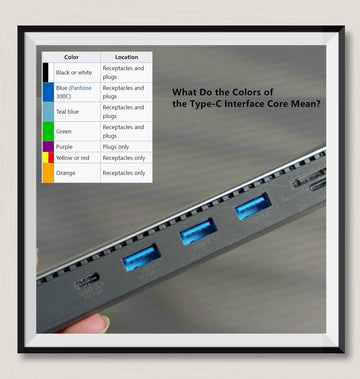Disassembly report: Anker 6-in-1 USB-C docking station A8365
Contents
MOKiN focuses on the field of docking stations, so from now on, the new series of articles will gradually analyze the products of more mature brands on the market and make fair tests and evaluations.
Anker has launched a 6-in-1 USB-C docking station. This docking station has two USB-A interfaces, a USB-C interface, an HDMI interface, and a Gigabit network interface, and supports six interfaces to be expanded at the same time. The docking station comes with a USB-C cable for connecting to a computer, and the HDMI interface has a 4K 30Hz output, which can be connected to a monitor and a projector.
This docking station supports 65W input power, and can power the connected laptop through the docking station. The USB-A interface can be used to connect a keyboard, mouse, and storage device. Below, MOKiN will bring you the disassembly of this 6-in-1 docking station from Anker to see the internal materials and artistry.
1. Appearance:
——————————

The packaging box is classic and very simple, with the ANKER brand printed on the front.


When the product is taken out, a plastic film is attached to the body.
The plastic film is printed with three points to note about the product:
- The USB-C port is not supported to achieve screen projection through the USB-C to HDMI/DP/Mini DP/VGA cable.
- Heating when fully loaded or connected to a PD adapter is normal.
- USB-A or USB-C data interfaces do not support charging.

The ANKER brand is printed on the USB-C cable shell.
The cable body is woven from two strands of silver and black, and the overall smoothness is burr-free.
Both ends of the cable body are protected against bending.
2. Port:
——————————
Anker's sleek, elongated six-in-one USB-C docking station boasts a premium silver-gray metallic finish that exudes quality. On one side, it features two USB-A ports capable of data transmission at a swift 5Gbps rate. Nestled between these ports is a blue indicator light that illuminates when the device is powered on.

On the opposite side, you'll find an HDMI port and two USB-C interfaces. One USB-C port supports data transfer at 5Gbps, while the other serves as a high-speed charging input, accommodating 65W PD input. This makes it ideal for charging your laptop when connected to the docking station.
The HDMI interface, as per the official product description, is capable of delivering crisp 4K high-definition projection. At the end of the unit, there's a gigabit network port for your networking needs.
The bottom of the docking station is adorned with laser-engraved product details, model information, and boasts certifications such as FCC and CE, ensuring its compliance and reliability.

The USB-C cable supplied with the docking station is precisely 18.5 centimeters in length.
The docking station's body dimensions are as follows: it measures 132.16 millimeters in length, 22.66 millimeters in width, and has a thickness of 18.41 millimeters.

The size of the product can be intuitively felt in the hand.
In addition, the net weight of the expansion dock is measured to be about 81g.
3.Disassembly of the docking station:
——————————
Let’s disassemble it and take a look at the internal design.

First, remove the plastic shell of the network port of the expansion dock and push out the internal PCBA module.

The PCBA module is covered with an aluminum alloy shell and grounded with conductive cloth.
The aluminum alloy shell is fixed by buckles.

The entire expansion dock PCBA module is covered and shielded by an aluminum alloy shell.

Remove the aluminum alloy shielding shell and stick Mylar sheets on the internal PCBA module for insulation.

Tear off the Mylar sheets on both sides of the PCBA module and continue disassembly.

A side view of the PCBA module, with a small board fixed by welding.

Remove the front panel after welding and continue disassembly.

The front of the PCBA module is shown with the HDMI socket, USB-A socket, USB-CA socket and network cable socket welded.

The back of the PCBA module is welded with the video conversion chip, USB-C control chip, hub chip and network port conversion chip.

The USB-C controller model VL103-Q4 is a highly integrated DP converter and PD3.0 controller suitable for USB-C video converters and USB-C multi-function converters.
VL162 USB Type-C multiplexer, data switching switch supports USB3.2, adopts QFN-28 package, and is used for forward and reverse insertion function of USB-C interface.

The DP to HDMI chip model IT65631 is a high-performance single-chip converter for DP 1.2 to HDMI 1.4 output of the USB-C port, supporting 4K@30Hz and 1080P@120Hz refresh rates.

27.000MHz provides the clock for the video conversion chip.

The docking station has a built-in USB HUB chip model VL817-Q7, which is a 5G-speed hub chip for USB interface expansion.
VL817 has an external 25.000MHz clock crystal oscillator.

The network port conversion chip model AX88179A is a USB3.2 to Gigabit Ethernet control chip, which is backward compatible with other modes.
The 20.000MHz crystal oscillator provides the clock for the AX88179A.

The AX88179 external memory model is 25Q20, with a capacity of 256KB.

Network transformer model TFS5009, SMD welding.

There is also a small board on the expansion dock PCBA module, which is connected by welding. A synchronous buck-boost circuit is welded on the small board for voltage conversion.
The synchronous buck-boost converter comes from MPS, with screen printing 9247. It integrates two lower tubes internally and two upper tubes externally to form an H-bridge.
A MOS tube is used in conjunction with a buck-boost converter.

The output filter capacitor is from PolyCap, which is an RN series miniaturized solid-state capacitor with a specification of 330μF 6.3V.
MOKiN disassembly revealed that Baraka's products are widely used in chargers, car chargers, wireless chargers, mobile power supplies, energy storage power supplies and other fields, and are adopted by many products of well-known brands such as OPPO, vivo, Xiaomi, Honor, Samsung, Huawei, Lenovo, ZMI, Nubia, Bull, ANKER, MOKiN, etc., and the products have been highly recognized by the market.

The ports are fixed by through-hole welding.

The overcurrent protection chip model ETA6280 for the USB-A interface has programmable protection current, 6.1V overvoltage protection, 2A continuous load current, and a built-in 70mΩ power switch.
The overcurrent protection chip model used for the other USB-A port is the same

AOS Bandai AONR21357 PMOS is used for power supply control, with a withstand voltage of 30V, a resistance of 6.3mΩ, and uses a DFN3*3 package.
The other MOS tube has the same model.
4. Disassembly Summary:
——————————
This 6-in-1 docking station from Anker has six interfaces, including two USB-A interfaces, one USB-C interface for power supply, another USB-C interface for data transmission, a 4K resolution HDMI interface, and a Gigabit wired network interface. The docking station comes with a USB-C cable, which can be used to expand peripherals for computers or mobile phones and can also charge connected devices through the docking station.

Through disassembly, it is learned that this docking station from Anker uses an aluminum alloy shell, and the internal PCBA module is also covered and shielded with an aluminum alloy shell. This docking station uses three chips from Weifeng Electronics, VL103+VL162+VL817, for USB-C interface control and USB HUB function and uses iTE Lianyang IT65631 for DP conversion to HDMI1.4 for HDMI interface output. Use Yalian Electronics AX88179A for network port conversion, and use an MPS synchronous buck-boost converter for voltage conversion to power the docking station.

MOKiN 13-IN-1 USB-C Laptop Charging Station with 2.26-inch LCD Smart Display








